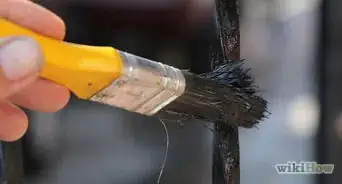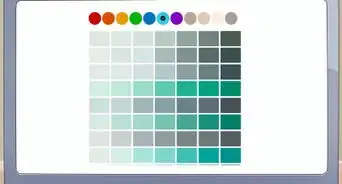This article was co-authored by wikiHow staff writer, Christopher M. Osborne, PhD. Christopher Osborne has been a wikiHow Content Creator since 2015. He is also a historian who holds a PhD from The University of Notre Dame and has taught at universities in and around Pittsburgh, PA. His scholarly publications and presentations focus on his research interests in early American history, but Chris also enjoys the challenges and rewards of writing wikiHow articles on a wide range of subjects.
wikiHow marks an article as reader-approved once it receives enough positive feedback. In this case, 86% of readers who voted found the article helpful, earning it our reader-approved status.
This article has been viewed 171,014 times.
Learn more...
Paint is one of the most common pool surfaces. It comes in a variety of colors and is an inexpensive alternative to the more elaborate surface options. When attempting to paint a pool, one must first select the proper paint, prepare the pool properly, and follow all manufacturer's application guidelines. With the right materials, and some time and effort, you can have a brand new swimming pool without breaking the bank.
Steps
-
1Purchase the same type of paint previously used on your pool surface: epoxy, chlorinated rubber or acrylic.[1]
- Remove a chip and have it tested by your local paint dealer to determine the type of paint that was used.
-
2Drain all of the water from the pool and remove any leaves, dirt or debris.[2]Advertisement
-
3Caulk or patch any existing cracks and holes with hydraulic cement. Follow the cement manufacturer's instructions.
-
4Clean the concrete surface.[3]
- Remove any old paint by using a power washer or a scraper and wire brush. Ensure that all loose paint has been removed, then sweep the area clean.
- Use an acid wash mixture of 50% water and 50% muriatic acid to clean the pool surface. Thoroughly scrub the walls and floor with a scrub brush, then rinse the entire surface with clean water.
- Clean the surface again with tri-sodium phosphate (TSP) to neutralize the acid and remove dense areas of oil or grease. Rinse it completely with fresh water.
-
5Re-rinse the entire pool, including drains, lights, stairs, etc. Pump out any standing water and allow 3-to-5 days for the pool surface to dry. Only acrylic paint can be applied to damp surfaces.[4]
-
6Apply the paint with an extension roller. Start in the deep end and work your way into the low end of the pool. Use a brush to cut in on the tight areas around pool fixtures such as lights, drains and valves.
-
7Allow the paint to dry per the manufacturer's instructions, particularly when using an epoxy paint as timing is crucial to proper adhesion. Typically, you must wait 3-to-5 days for the paint to dry before refilling the pool with water.[5]
-
8Refill the newly painted pool with water and adjust the filter and chemical settings to ensure proper maintenance.
Community Q&A
-
QuestionHow long can I expect a high-quality pool paint to last?
 Community AnswerIt depends on how much you use your pool, whether it's indoors or outdoors, and if you keep the water properties in control. Five years is a conservative estimate.
Community AnswerIt depends on how much you use your pool, whether it's indoors or outdoors, and if you keep the water properties in control. Five years is a conservative estimate. -
QuestionDoes pool paint have a traction additive?
 Community AnswerNot that I have heard. I used clear sand and sprinkled areas that need traction while the paint is still wet.
Community AnswerNot that I have heard. I used clear sand and sprinkled areas that need traction while the paint is still wet. -
QuestionHow do I tell what kind of paint is on my pool?
 Community AnswerYou can take a sample of it to get evaluated, or you can purchase a paint that is suitable for the pool and paint over the paint that is already there.
Community AnswerYou can take a sample of it to get evaluated, or you can purchase a paint that is suitable for the pool and paint over the paint that is already there.
Warnings
- Take the necessary safety precautions when using the acid wash solution, as it may be harmful to your eyes, lungs and skin.⧼thumbs_response⧽
Things You'll Need
- Muriatic acid
- Epoxy/acrylic/chlorinated rubber paint
- Paint roller pans
- Paint rollers with extension pole
- Paintbrushes
- Rubber gloves
- Power washer
- Safety goggles
- Scraper
- Scrub brush
- Tri-sodium phosphate



































































